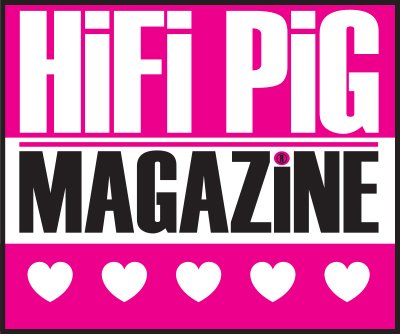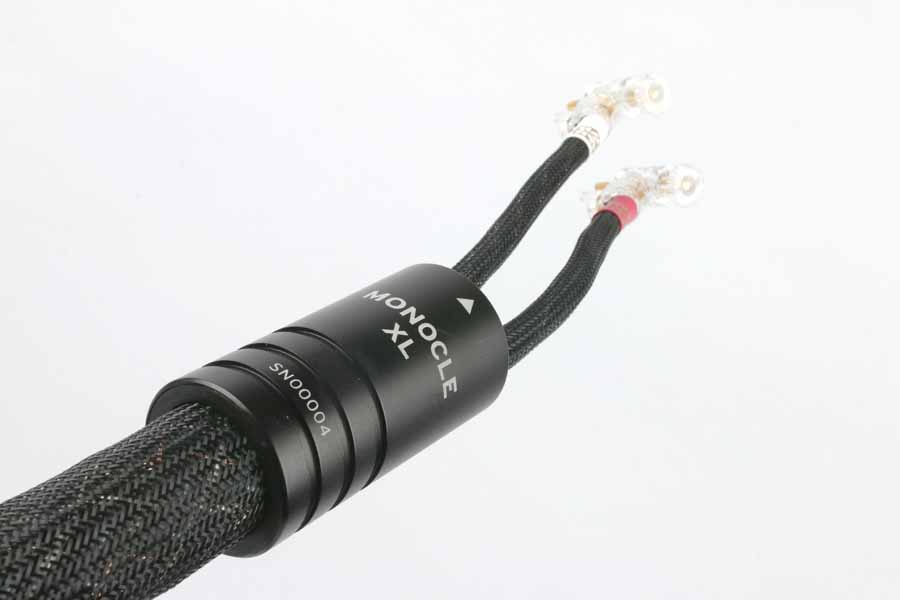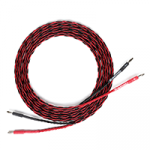KIMBER CABLES 8PR AND 4PR SPEAKER CABLE REVIEW
Kimber Kables 8PR and 4 PR Speaker Cable, distributed in the UK by Russ Andrews are braided cables with 4 or 8 pairs of cables per channel. Janine Elliot tries out these relatively affordable loudspeaker cables for HiFi PiG.
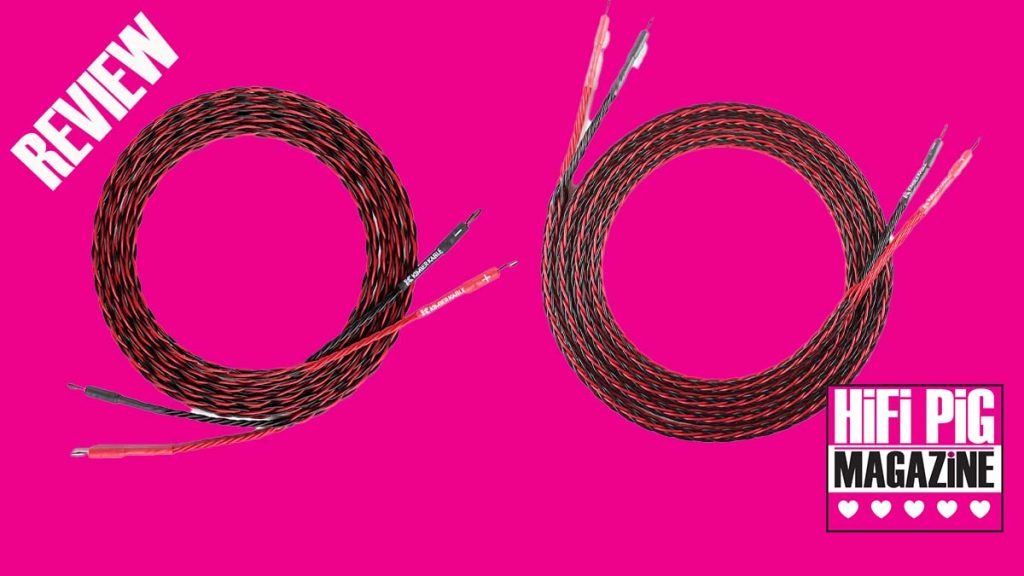
When I was a child in the mid 70’s I was playing about with some cheap thick multi-core speaker cables, similar to the then excellent QED 79 strand cable introduced in 1975, having just binned my previous bell-wire. It sounded so much better and got me started in studying the properties of cables, which wasn’t much then, but based around the right-hand-rule showing the link between current direction and magnetic field that I picked up in physics lessons at school. So, I decided to weave three twin cables into a ponytail-type contraption. I not only thought that using much more wire would mean even better sound, but that having the wires at angles to each other in a braided structure would provide effective electromagnetic shielding by preventing the wire itself from emitting EMI. I didn’t realise that it would also protect the wires from external electromagnetic interference. It looked a mess, and I quickly updated it to QED 79, which was better, of course.
Roll on 1979 and Ray Kimber in America created his first speaker cables, the 4PR and 8PR. The former was a 4-wire set of red and black (for positive and negative) cables braided together in a counter-opposed helix design, meaning a total of 8 wires. The 8PR therefore meant that there was a total of 16 red and black cables beautifully wound together, which would look lovely as a work of art in Tate Modern. Luckily it wasn’t encased in an outer jacket, which would spoil the looks though maybe give it more vibrational protection. Kimber’s next big innovation was the Vari-Strand (VS) conductor, where inside the polyethylene insulation there were copper strands of different diameters (7 wires altogether), in order that the cable didn’t just favour one set of frequencies, but would work across the complete frequency range needed for successful music and speech creation. So came the 21st century iteration of the 4PR and 8PR which combines both aspects of the original PR and VS cables into a single product, meaning the 4PR and 8PR have been in existence for an amazing 45 years, and still retains an important position in the KK portfolio. Starting at £20/m and £40/m for the 4PR and 8PR respectively, these are very good value in the twenty-first century.


TAY KIMBER, BRAIDS AND DISCOS
To put all the above into context one needs to know about Ray’s early career. Mid 70’s RK worked at a sound and lighting company in LA. These were early days of discotheques and most installations had the audio and lighting cables connected close together. As a result, Ray observed that the speaker cable acted as an antenna from the lights, adding noise into the audio. Ray had the idea that if you counter-rotate sets of conductors to cancel the magnetic interaction, the sound wouldn’t be so noisy. By using braided wire, Ray noticed that as well as rejecting the RF noise it made the music sound better. Hence Kimber Kable was founded in 1979, whilst I was still using QED. Since that date, if you think of braided wire, you naturally think of Kimber Kables. Having to actually manually wind the cables in that manner was a massive and time-consuming task, and therefore Ray had to develop in-house the machinery and processes to enable him to do it cheaply and quickly. The whole concept of cable design from Kimber Kables has been favoured by a number of product companies; Sony, for example, deployed Kimber Kables cable in their DAPs and headphones, and they even used Ray’s cable on their flagship SS-AR1 speaker project design.
BUILD QUALITY AND FEATURES OF KIMBER PR SPEAKER CABLES
The 4PR and 8PR are nothing special in terms of construction. There’s no hidden agenda here; the 8 or 16 wire braided design in counter-opposed helix design is visible for all to see. There is no outer jacket to hide the design or work as anti-vibration material. Each of the wires contains 7 Kimber high-purity OFE (Oxygen-Free Electrolytic) copper strands of 4 different sizes (Vari-Strand) housed in a dielectric made of polyethylene. The different sizes help to stop favouritism of a specific area of frequencies is the claim.
Since there is much air between the conductors, the cables are very easy to position around your living room furniture.
Supplied in the UK by Russ Andrews, a longtime fan and friend of Ray Kimber, these cables are at the lower end of their portfolio. Where the 8PR is twice the price of the 4PR, coming in at £40/m and £20m respectively per metre off the reel, this makes them cheaper than many top-end cables that sound no better. You can select your own termination options at each end of the cable, including nitrogen-assisted hand-soldered bare ends, banana plugs, or spades. A 3.5m pair of 8PR with 4mm banana plugs costs a very respectable £448, whereas Kimber’s top-end Select KS-6068 with WBT-0610AG bananas cost a mind-boggling £43,428 for the same length.
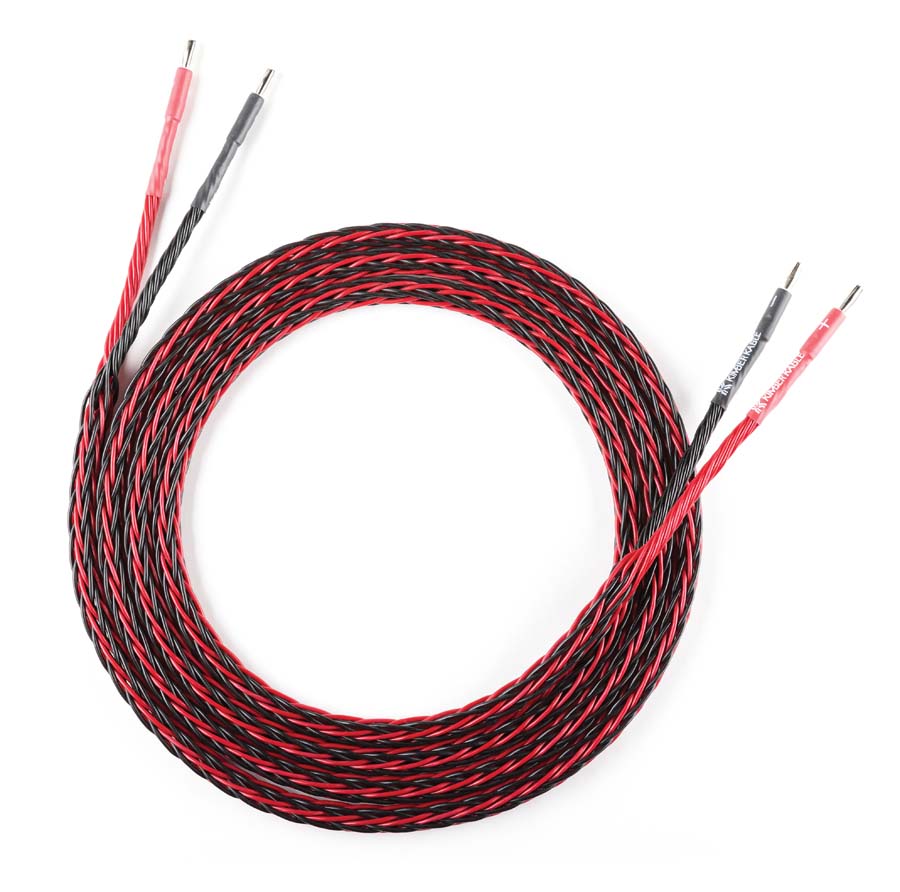
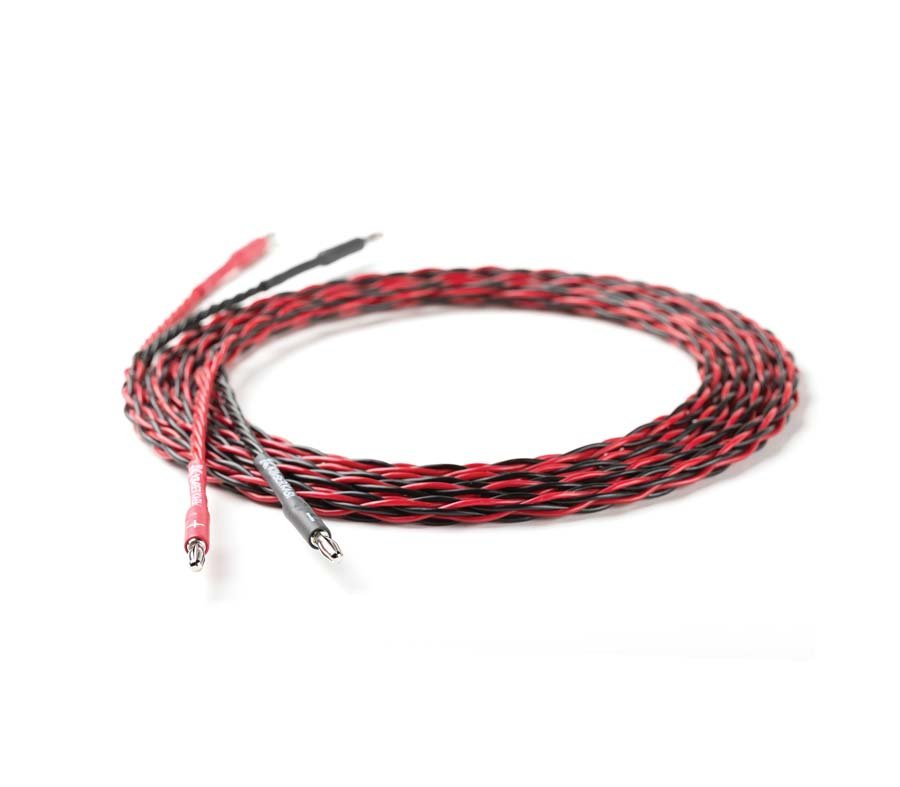
SOUND QUALITY
First to be listened to was ‘A Kind of Blue’ Miles Davis, recorded back in 1959 but on 21st century 160g remastered vinyl. This is a very well-regarded performance and recording, which can sound different on different cables and separates. For example, the breaths from the saxophones and peaks from the trumpet can either sound amazing or come across as if something is wrong, depending on your cartridge set up, cables, and electronics. This Columbia Records recording re-released by Sony Music in 2015 sounded pretty spectacular through the Kimber Kabless, with a tight and very clear account of all instruments, including the breaths from the trumpet and gurgling sound from John Coltrane on tenor sax, and John Adderley on alto sax in “So What”, one of Miles’s best-known tracks with his iconic repetitious ostinato or riff – a choice of term depending on whether you are a classical or jazz aficionado. I felt the double bass detail wasn’t as clear as on some more expensive cables, but the 8PR had more “bite” than the 4PR.
From an old and very famous album to the very latest from a very famous heavy rock band YES. Released in 2023, I have been listening a lot to this double album over the past year on different HiFi setups. The opening of “Cut From The Top”, with Jon Davison singing a style very similar to the original and best voice of all-time Jon Anderson, who set up the band with drummer Chris Squire in 1968. Jon Davison, who joined YES in 2012, has a clear and highly enjoyable vocal from the speaker cables, though the opening instrumental was a little cloudy. My favourite track from this album “All Connected” was more connected between the instrumentalists and vocals and gave a good sense of focus and transparency. Guitarist Steve Howe’s guitar glissandi were clear and lifelike, as were the synthesizer muted arpeggios (sounding like a zither) in track 3, “Luminosity”. Here, the ascending modulations add to the emotions of the track, reminding me somewhat of the album ‘War of the Worlds’ from Jeff Wayne.
Changing the mood somewhat I decided to try ‘Come Fly With Me’, a remake of the 1982 Philips LP, an album, like many, that miraculously disappeared from the company that used to make HiFi before turning to back-lit televisions and electric toothbrushes. This is my favourite album of this genre, not only for the sound quality but also for the excellent piano playing from Jochem Braat, as well as the excellent Adrie Braat on bass and Tijn Jans on drums, who make up the “Amsterdam Jazz Trio”. Recorded on reel-to-reel and converted to 88.2kHz/24bit to create the digital master for the CD version, the original analogue tape is used to make the LP and tape copies. My copy is on CD, played through my excellent Krell KPS20i. The performance is exceptionally clean and detailed at all frequencies, highlighting the philosophy of the Vari-Strand cables. The 8PR was more detailed and musical than the 4PR, though the extended bass from the double bass was slightly more forward and could be a little too much at times, though it never sounded dull or slow. There is lots of “air” and “space” in the top frequencies, helping to show off all the reverb and atmosphere.
“Hawaiian War Chant” (Syd Lawrence Orchestra, Chasing the Dragon) was a little brittle in places, though the higher brass notes showed the amount of top frequency detail extracted through the cables to the speakers. Similarly, the hall ventilation system in the building where the Darbourne Ensemble playing “Nolo Mortem Peccatoris”, written by Thomas Morley in the 16th century, was recorded (again by Chasing the Dragon) was similarly (and annoyingly) too loud, though the music sounded as fresh as it was five centuries ago. On to reel-to-reel, I first played an original 7½ ips recording of ‘Tapestry’ from Carole King. This album was highly musical with very clear vocals and the position of the instruments and backing vocals was maintained accurately. Acoustic guitar melodies were played with detail and musicality as were the top frequencies in “So Far Away”. Her famous track “Will You Love Me Tomorrow?” had similarly good vocals and guitar. That bass end detail was again notable in “You’ve Got a Friend”, sounding better on the 8PR than the cheaper cable.


Also on reel-to-reel, the excellent ‘Vivaldi in London’ album from Chasing the Dragon had a sense of air and space that helped capture the musicality from the Interpreti Veneziani Ensemble beautifully. The powerful start of the Concerto for Cello, Strings, and Harpsichord in Bb, RV 419 got my attention from the first bar. The third and final movement is my favourite Vivaldi concerto movement. Such a powerful and sadly short piece that showed off the 9-piece ensemble magnificently. The Kimber Kabless worked at their best to not only give an excellent cello, but the tight harpsichord notes were also as realistic as if I were sitting in front of the musicians themselves. Only at times did the mid-frequencies seem a little less controlled. The bass was very clear and the top-end from the harpsichord made for an exhilarating performance.
I was mightily impressed by the bang per buck of these cables, particularly the 8PR. There is no magic in these cables, unlike some manufacturers who claim their cables are made from gold dust rather than the customary 7N copper. This is just a 45-year-old design with very clever weaving and the addition of their more recent patented Vari-Strand technology.
If it works, why change it?
CONCLUSION
Some cable manufacturers might concentrate on heavy low resistance conductors or ergonomics to reduce electrical interference, or heavily sheathed cables to hide the innards and reduce mechanical interference, and, of course, special dielectric compounds. I have come over the years and through reviewing and listening to so many cables that no one method (or combination) is best. All cables have their own DNA just as HiFi components make their own signature sounds.
The 8PR is not the cheapest of cables, but what makes it special is the fact that it can liven up your system, particularly if it generally sounds dull or slow. Where my own DIY plaited cable failed when I was a teenager, Kimber’s beautiful red and black braiding designed to produce low inductance, plus the Vari-Strand technique is pure brilliance. If you need your HiFi to wake up a little bit then this cable could awaken your enjoyment of the music, and if you can’t afford the 8PR, then the 4PR at half the price is more than half as good.
AT A GLANCE
Build Quality:
Beautiful and cleverly assembled
Excellent termination
Sound Quality:
Excellent across all frequencies, with extended and detailed bass end
Value For Money:
At £20 and £40 per metre from the drum, these cables are competitively priced. Even assembled with spades or bananas these are surprisingly cheap for the quality of build and performance.
We Loved:
Focus and transparency
Detailed performance
Extended bass
Good 3D soundstage
We didn’t Love so much:
Sometimes mid-frequencies weren’t as defined as more expensive cables, but at their price there is very little to criticise.
Price:
4PR £20/m off the drum; 3.5m/pair with 4mm banana plugs £255
8PR £40/m off the drum; 3.5m/pair with 4mm banana plugs £448
Elevator Pitch Review: Think of braided cables and you automatically think of Ray Kimber. Having been interested in the idea of ponytailing cables to reduce RF interference and induction since I was a teenager it was a privilege to finally listen to a Kimber Kable in my system. The 8PR and 4PR are at the low end of their portfolio and have their roots in the original PR’s of 1979. They worked then, and now adding Vari-Strand technology made for an even better performance. Starting at £20/m they work well with any mid or hi-end system, as I discovered.
Janine Elliot
SUPPLIED SPECIFICATIONS
‘PR’ design now with Kimber VariStrand™ (VS) conductors
Kimber’s own high-purity OFE (oxygen free electrolytic)
8PR; 16 strands of 19.5 AWG OFE (oxygen free electrolytic) copper. (102% IACS). Aggregate combination of 8, 19.5AWG strands≈10AWG per +/- leg. LOW series induction design: 0.14 uH / meter.
4PR; 8 strands of 19.5 AWG OFE (oxygen free electrolytic) copper. (102% IACS). Aggregate combination of 4, 19.5AWG strands≈13AWG per +/- leg. LOW series induction design: 0.23 uH / meter
Polyethylene dielectric. Black/Red
















































